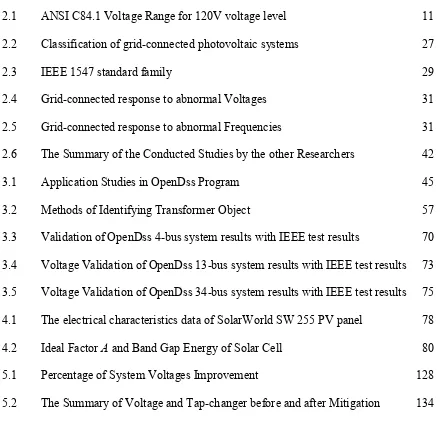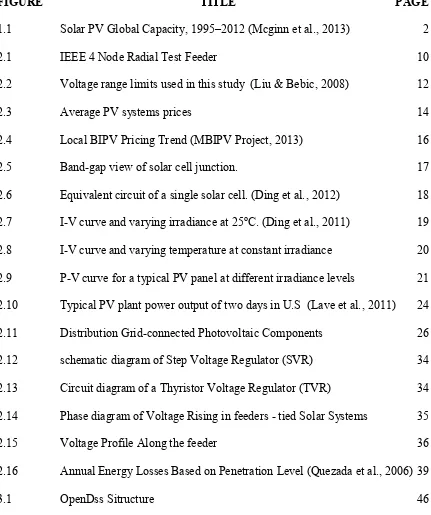Master of Electrical Engineering (Industrial Power)
Faculty of Electrical Engineering
IMPACT OF PHOTOVOLTAIC SYSTEMS INTEGRATION
ON ELECTRICITY DISTRIBUTION NETWORKS
IMPACT OF PHOTOVOLTAIC SYSTEMS INTEGRATION ON ELECTRICITY DISTRIBUTION NETWORKS
WADHAH ESMAEEL IBRAHEEM
A dissertation submitted
In partial fulfillment of the requirements for the degree of Master of Electrical Engineering (Industrial Power)
Faculty of Electrical Engineering
UNIVERSITI TEKNIKAL MALAYSIA MELAKA
Examiner Approval sheet
IMPACT OF PHOTOVOLTAIC SYSTEMS INTEGRATION ON
ELECTRICITY DISTRIBUTION NETWORKS
By
Wadhah Esmaeel Ibraheem
Dissertation accepted as conforming to the required to requirements for the degree of Master of Engineering and approved by the examining committee
Assoc. Prof. Dr Zulkifilie Bin Ibrahim
Dean of Electrical Engineering Collage Chairman
Datuk Prof. Dr Encik
Mohd Ruddin Ab Ghani Khairul Anwar bin Ibrahim First Examiner Second Examiner
1 DECLARATION
I declare that this dissertation entitle ―Impact of Photovoltaic Systems Integration on Electricity Distribution Networks‖ is the result of my own research except as cited in the references. The dissertation has not been accepted for any degree and is not concurrently submitted in candidature of any other degree.
Signature :………. ...
Name :………. ...
2 APPROVAL
I hereby declare that I have read this dissertation and in my opinion this dissertation is sufficient in terms of scope and quality for the award of Master of Electrical Engineering (Industrial Power).
Signature :………. ...
Supervisor Name :……… ...
3 DEDICATION
I dedicate my dissertation work to my family and many friends. A special feeling of gratitude to my loving parents, Esmaeel Ibraheem and Najiyah Tareq whom words of encouragement and a push for tenacity to improve myself throughout all my walks of life. Thank you for giving me a chance and I love you.
I also dedicate this dissertation to my brothers Mustafa and Suhaib who have supported me throughout my life. I always miss and I cherish the memories that we had. I love both of you.
4 ABSTRACT
ii 5 ABSTRAK
6 ACKNOWLEDGMENTS
In preparing this dissertation, I was in contact with many people, researchers, academicians and practitioners. They have contributed towards my understanding and thought. In particular, I wish to express my sincere appreciation to my main supervisor, I thank to my supervisor Dr. Gan Chin Kim with all of my heart who gave me encouragement, guidance and support from the initial to the final level of my dissertation.
I am also very thankful to lecturers and professors in Universiti Teknikal Malaysia Melaka (UTeM) for their guidance, advices and motivation. Many thanks to my teachers in the first degree in Diyala University. I appreciate their continued support and interest in my course study.
I am also indebted to Universiti Teknikal Malaysia Melaka (UTeM). They deserve special thanks for their assistance in supporting students by conferences, technical talks and workshops.
iv
2.1 Distributed Generation: Photovoltaic Systems 7
2.2 Distribution system 9
2.3 Photovoltaic System (PVs) 12
2.3.1 Deployment of PV System 12
2.3.2 Characteristics of PV Module 16
2.3.3 PV System Inverter 22
2.3.4 Fluctuations of the Power Generated from PV Systems 23
2.3.5 Solar Photovoltaic Integration 25
2.3.6 Types of Grid-tied Photovoltaic Systems 26
2.4 Impact of Grid-connected Solar PV Systems 28
2.4.1 Impacts of PV Systems on Voltage Profile 32 2.4.2 Mitigation methods for voltage problems 33 2.4.3 Impacts of PV Systems on Network Losses 39 2.5 Penetration level of Grid-connected PV systems 40
3 OPEN DISTRIBUTION SYSTEM SIMULATOR (OpenDss) MODELING 44
3.1 Introduction 44
3.2 Simulation Capabilities 46
3.2.1 Power Flow Solution 46
3.2.2 Fault Studies Solution 48
3.2.3 Harmonic Analysis 48
3.2.4 Dynamics Simulation 49
3.3 OpenDss Architecture of Models 49
3.4 Circuit Modeling Basics 51
3.4.1 DSS connection models (Buses and Terminals) 52
3.4.2 Power Delivery Elements 53
3.4.3 Power Conversion Elements 54
3.5 Distribution System Circuit Modeling 55
3.5.1 Initial Definition with Voltage Source Object 56
3.5.2 Transformer Modeling 57
3.5.3 Line Object Modeling 59
3.5.4 Load Object Modeling 63
3.5.5 Recording Elements (Monitors) 64
3.5.6 Solving and Showing Results Reports 66
3.6 Validation of OpenDss with IEEE Test Feeders 66
4 MODELING AND SIMULATION 76
4.1 Simulation Tools 77
4.2 Photovoltaic Power Generation model 77
4.2.1 V-I Characteristics Modeling 77
4.2.2 Time series PV Power Generation Model 84
4.3 PV Impact Analysis on Distribution System Networks 86 4.3.1 Distribution System Voltage Performance Analysis 87 4.3.2 Impact of PV Generation of the Feeder Losses 93 4.3.3 Study on The Penetration Level of Grids-connected PVs 95 4.4 Mitigation of Voltage Fluctuation by STATCOM Compensation 100
5 RESULTS AND DISCUSSION 102
5.1 Solar Photovoltaic Panel Generation 102
5.1.1 V-I Characteristics of PV system 103
5.1.2 Daily Solar PV power generation 106
5.2 Steady State Voltage Improvement in Distribution Networks 110 5.3 Voltage Improvement Based on Daily Time Series 114
5.4 Losses Impact on Grid-connected PV Systems 117
5.5 Penetration Level of PV System in Distribution Networks 121 5.5.1 PV Penetration Limit of 34-bus Test System 121 5.5.2 Impact of PV Penetration on Distribution Network under
Various Load Levels 124
5.6 Mitigation of Voltage Fluctuation by STATCOM Compensation 129
6 CONCLUSIONS AND FUTURE WORKS 135
6.1 Conclusions 135
vi
6.3 Future works 139
7 REFERENCES 140
8 APPENDICES 147
8.1 APPENDIX A 147
8.2 APPENDIX B 150
8.3 APPENDIX C 168
9 LIST OF TABLES
TABLE TITLE PAGE 2.1 ANSI C84.1 Voltage Range for 120V voltage level 11 2.2 Classification of grid-connected photovoltaic systems 27
2.3 IEEE 1547 standard family 29
2.4 Grid-connected response to abnormal Voltages 31 2.5 Grid-connected response to abnormal Frequencies 31 2.6 The Summary of the Conducted Studies by the other Researchers 42
3.1 Application Studies in OpenDss Program 45
3.2 Methods of Identifying Transformer Object 57
5.20 Feeder Losses with Different PV System Capacities 119 5.21 U-shape Trajectory of The Losses Behavior in IEEE 13-bus System 120 5.22 Maximum Allowable Injected Power at Bus 814 122 5.23 Maximum Allowable Injected Power at Bus 824 122 5.24 Maximum Allowable Injected Power at Bus 836 123 5.25 Maximum Allowable Injected Power at Buses 814, 824 and 836 Together 124
5.26 IEEE 4-Bus Test System 125
5.27 Voltages in Different Percentages of Maximum Demand 127
5.28 System voltages regulation 128
5.29 Voltage Profile before STATCOM Mitigation 129 5.30 Tap-changer Movement before Mitigation 130 5.31 Voltage and Tap-Changer Profiles of IEEE 34-Bus System with
Mitigation Control 132
5.32 Voltage and Tap-Changer Profiles of IEEE 34-Bus System with
xii
11 LIST OF APPENDICES
APPENDIX TITLE PAGE
A SolarWorld Catalogue SW 255 mono PV model 147
B IEEE Distribution Test Feeders System B1. IEEE 4 Node Test System
B2. IEEE 13 Node Test System
B3. IEEE 34 Node Test System
150 150 155 162
C OpenDss and MATLAB Codes 168
12 LIST OF ABBREVIATION
PES IEEE Power and Energy Society
IEEE Institute of Electrical and Electronics Engineers ISE Interconnection System Equipment
IEA International Energy Agency
MBIPV Malaysia Building Integrated Photovoltaic
MPP Maximum Power Point
STC Static Synchronous Compensator Standard Test Condition SVR
TCC Fuse Step Voltage Regulators Time-Current Characteristic Fuse TNB
TVR Tenaga Nasional Berhad Thyrisor Voltage Regulator UL
xiv
13 LIST OF PUBLICATION
Journal
[1] W. E. Ibraheem, C. K. Gan, ―Effect of technical impact of PV penetration on distribution network under various load levels‖ Applied Mechanics and Materials, ISSN 1660-9336, May 2014. (Accepted and to be appeared in May 2014 issue), Scopus-indexed
CHAPTER 1
1 INTRODUCTION
1.1 Research Background
These days the demand for electrical energy is increasing to meet the load expansion in the electrical power system. The rise of the world weather temperature and the depletion of fossil fuel and the price of the fuel had motivated more researches and development in renewable energy system (RES). This is to reduce the CO2 emission.
Many countries have engaged in renewable electricity and they have set ambitious for producing power from green sources to meet the expected demand in the coming years.
Photovoltaic (PV) solar energy is one of the important sources of the renewable energy; it has grown in many countries steadily in the last few years. In Europe, the combined target yield a total expected PV power generation capacity is 84.4 GW by 2020, where the maximum projected PV target is in Germany which is around 51.8 GW from solar energy (Pearsall, 2011). In Malaysia according to the 10th Malaysian plan (2011-2015) the PV generation in the country will reach 65 MW in 2015 and it is projected to be 190 MW by 2020 (Shamsuddin, 2012). U.S. imports of PV products from South Korea are small, but the country has a stated goal to capture 10% of the global PV market by 2020 (Platzer, 2012).
2
the environment as well as it saves the depletion of fossil fuel and coal. The variability in the output of the PV panels is a natural behavior of these resources and it is a significant issue. The rising and setting of the sun lead to a regularly variation of the PV panel generation over the daily time period. In addition, the output can be decreased to 50%-80% when the clouds pass over PV plants (Kleissl, 2012). In this case a backup power will be required to cover the output variable to maintain the operation voltage under the limit. If the response of the backup elements is too slow to cover the problem, power quality can adversely affected.
Despite these difficulties, solar PV plants still have the fastest growing of renewable energy technology in 2012. As shown in Figure 1.1 a predestined that 29 GW of the solar capacity in 2012 have been added to the power capacity which was in 2011. The power was almost 150% has increased of the installed capacity of 2010 bringing the totally generation about 100 GW (Mcginn et al., 2013).
As the rapid increasing of the PV integration, it could potentially bring problems in terms system operation where a reverse power can be introduced by higher penetration levels resulted a rise in bus voltages and feeder loses (Agalgaonkar, 2013). Numbers of researches have been done in the recent years to evaluate the impact of PV system on power grids. The notable studies were by National Renewable Energy Laboratory (NREL) in February 2008, and the other one in 2002 which had been conducted by the
International Energy Agency (IEA) (E. Liu & Bebic, 2008) (Arne Faaborg, 2002). In
Malaysia, Tenaga Nasional Berhad (TNB) has provides a guideline and recommendations to the interconnection of PV systems with distribution grids (Tenaga Nasional Berhad, 2013). These studies included many reports of the PV impact on the distribution grids to address the analytical and technical issues of the high penetration level of distribution generation as in reference (Tie & Gan, 2013).
1.2 Problem Statement
U-4
shape trajectory of distribution networks losses is expected. In addition, voltage rise can be expected along the distribution system feeder as a result of the reverse power flow.
The rise of the voltage at the end-user limits the amount of the penetration level which wanted to be installed in the distribution network. The natural behavior of the solar source makes the generation of the PV plant systems in fluctuated profile. The rapid variation of the PV power introduces a voltage fluctuation along the PV working time and hence it effects on the voltage regulation in some cases.
1.3 Research Objectives
In a light of the issues described above, this research aims to analyze the impact of the PV system on distribution systems. The focus of this research is to evaluate the voltage and losses impact on the distribution feeders. The main objectives of this work are:
To model and simulate the commercially available PV panels and results validation with the product catalogue.
To investigate the impact of PV integration on distribution networks in terms of network losses at different PV locations and to evaluate the voltage impact under different PV penetration level and load levels.

